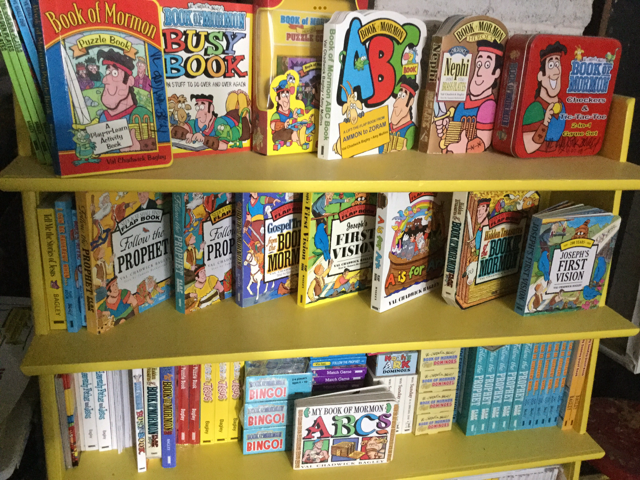Shortly after moving from our Utah home and settling near the Idaho/Wyoming border, I entered the Star Valley Temple with my husband and was greeted by a humble-looking man in a white suit, who scanned my recommend and welcomed me to the House of the Lord. I glanced at his tag and recognized his name right away.
“Val Bagley?” I said. “The artist?”
He gave me a small smile, said yes, and indicated which way I should go to find the changing room. The message was loving and clear—we were there to serve the Lord, not to chat about our outside lives or careers. Later, when my son served as a missionary in the temple, Brother Bagley was his shift leader, and continued to set a positive example of service and dedication to the task at hand. I did, however, have the chance to talk to him about his career on another day.

In 1978, the New Era magazine featured a cartoon drawn by LDS artist Val Chadwick Bagley. It was the first of more than a thousand cartoons he would draw for both the New Era and the Friend over the next 46 years, beginning an unexpected career.
“Pretty much most of my life, I’ve known what I wanted to do for a living,” he said on the occasion of his fortieth year in the industry. “I just didn’t know it would be drawing for the Church.”
His very first piece of art to be recognized in a Church magazine was actually published in the Friend when he was seven years old, but he threw his copy of the magazine away because he felt he could do better.
While serving as a missionary, he was assigned to be the mission public relations director, and he used his talents to fulfill this task. He drew pictures of visiting general authorities and illustrated the mission newsletter, and it was during this time that his first “official” drawing was accepted by the New Era, and he burst onto the scene.
Whether or not you’re familiar with his name, his unique art style sets him apart and makes him immediately recognizable. His characters have a youthful look—wide eyes, rounded angles, and stylized hands and feet. Those characters point out some of the gentle humor to be found in our church—always appropriate to the moment, never mocking, but recognizing that we do have funny moments as a people and celebrating that humor through art.
“My cartoons may be gospel-related, but they don’t have anything really to do with the gospel itself,” he shared. “For the most part, my cartoons are about people living the gospel, not the actual teachings themselves. I already know the New Era would never print a cartoon that made light of sacred things, which I wouldn’t draw anyway.”

Although starting as a magazine cartoonist, Val has since published several children’s picture books on a wide variety of topics, and also card games for LDS families. He does all this from a studio set in the peaked-roof attic of his house in Wyoming, where I was privileged to visit about a year ago with my family. The walls and the ceiling are covered with pieces of his original art, both published and some in various draft stages. His drawing table faces a window that looks to the east toward the mountains; not only a source of light for his work, but inspiration for his art. His home is just as bright and cheerful as his cartoons, decorated in a vintage fifties’-era style that’s both whimsical and inviting, exactly the sort of home you’d imagine an artist to have.
He has achieved success in his chosen field now, but after returning from his mission, he struggled to know if art—particularly cartooning—was the path he should pursue. He attempted college, but they weren’t teaching the things he wanted to learn, and his instructors encouraged him to give up and turn his attention to “serious art.” One day, while reading the Book of Mormon in the temple waiting room, he opened to Helaman 12:2:
Yea, and we may see at the very time when he doth prosper his people, yea, in the increase of their fields, their flocks and their herds, and in gold, and in silver, and in all manner of precious things of every kind and art . . .
The word “art” stood out to him, and he recognized that yes, there was a place for him and his unique talent. He had been drawing labels for cheese, but with this newfound conviction about his purpose, he approached Covenant Communications with the illustrations for a coloring book, which was published in 1992, and he continues to publish with them to this day.

I asked Brother Bagley what advice he would offer to artists hoping to break into the field. He laughed and said that he’s still trying to make it big himself and could use a little advice as well, but he offered the following tips:
- Practice, practice, practice. “Although I’ve always loved to draw cartoons, it took years and years of practice,” he said. “I would copy other cartoons that I liked and admired (Snoopy, mostly) until I developed my own drawing style.”
- Draw consistently. “I kept four cartoon journals on my mission (one for every six months), and that is when I really refined my drawing style.”
- Discover your intention. “I’ve never been a ‘doodler.’ I draw with purpose. My cartoons usually are telling a story or mean something. I don’t just draw to draw.”
- Keep going despite rejection. “I’ve illustrated/written over 100 books which have sold over 1,000,000 copies, but I still get rejected 75% of the time.”
My biggest takeaway from my time spent with Brother Bagley is the importance of seeking the Lord’s partnership whenever we undertake a piece of art meant to glorify Him or teach others about Him. Val Bagley is a humble man who speaks often of prayer as part of his creation process, and truly, when we do things in the way the Lord would have us do them, we can’t help but inspire those around us.





